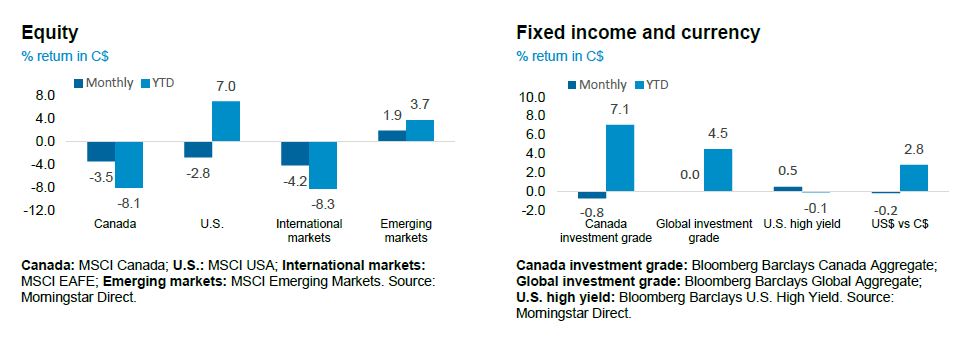Monthly Market Insights - Data as of October 31, 2020; opinions as of November 4, 2020
Who will be president?
The question of who will lead the United States of America for the next four years loomed large as ever on November 4. As of 11am ET, even without an election result to grasp onto, global stock markets were solidly in the green. One thing is clear as of this writing: the so-called blue sweep, with Joe Biden winning the presidency and Democrats taking control of the Senate, is now an unlikely outcome. The battle over Senate seats has turned into a much closer race than expected. Even if Biden wins, he’s likely to face tough challenges pushing policy change through Congress.
October was every bit as volatile as we’d expected, especially in the last two weeks, as investors positioned themselves ahead of election day, and with rising and falling hopes of a second fiscal deal before the election. Global stocks ended the month with a loss of 3.24% as measured by the MSCI World (C$).
The NEI perspective
No clear winner… yet. Election night ended with much uncertainty in the air as millions of ballots remain to be counted. While markets are still pricing in a Biden victory, it will likely come with Republicans holding the Senate, resulting in a divided federal government.
Renewed lockdowns. The appearance of second and third waves of the coronavirus have prompted nations to reinstate temporary lockdowns. These measures will no doubt have a negative impact on Q4 economic activity and are already reflected in equity market weakness.
Fiscal policy will drive the recovery. Renewed lockdowns mean there is even greater need for governments to support the economy. With monetary policy pushed close to its limit in many nations, we look toward fiscal policy to take center stage in supporting the recovery.

As of October 2020
Focus on policy, not politics
As investors await the U.S. election outcome, we would like to revisit a topic we discussed back in September. Conventional wisdom suggests that Republican presidents, given their pro-business stance (i.e., lower taxes, free markets) would be more favourable for markets compared to Democrats, who generally favour higher taxes and increased government regulation. History, however, shows markets can perform well under either administration. In fact, the chart below shows what would happen if investors were to only invest during either a Democrat or Republican president.
Best way to play U.S. elections? Stay invested.
Growth of $10,000 investing in the Dow Jones Industrial Average (price return, U.S. dollars)

Source: Bloomberg. Calculated using monthly return data from January 1937 to October 2020.
For this election, control of the Senate is just as important as controlling the White House. At the time of writing, the most likely outcome is a Biden presidency with a divided Congress, which will likely lead to further political gridlock. This would imply that any major policy changes that either candidate campaigned for are unlikely to come to fruition. On the one hand, this could mean little to no changes to Trump’s 2017 tax cuts. On the other hand, it could mean that subsequent fiscal packages will be smaller than what Democrats have been pushing for prior to the election.
All in all, the macro implications of this scenario would be relatively neutral to slightly deflationary. In the short term, between now and January 20 when the president is inaugurated, we would still expect a relatively high level of uncertainty as ballots are tallied up. If it turns out to be a close outcome, we can expect contention, perhaps followed by litigation.
Regardless of the outcome, the expected first order of business for the new administration will be to focus on the next fiscal package to combat the economic fallout from COVID-19. Wage support and its impact on consumer spending will be paramount in shaping the road to economic recovery as well as stock market performance.
